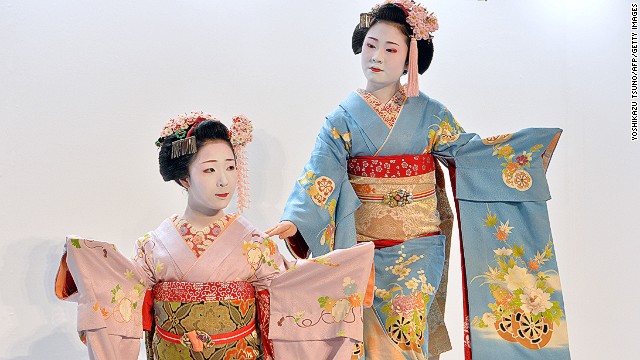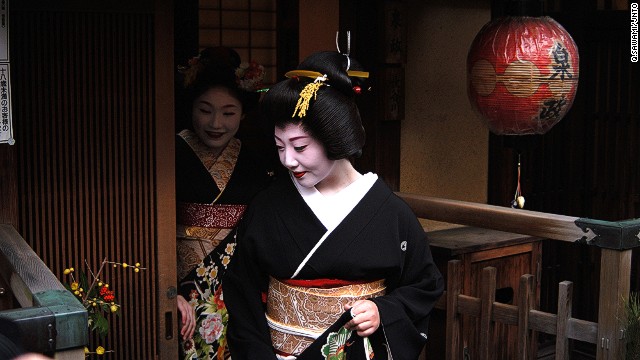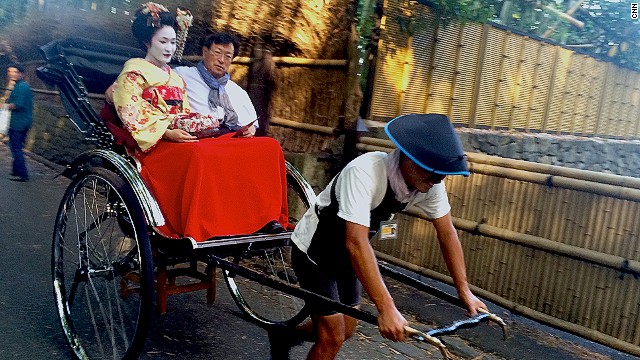 Geisha are found throughout Japan, but Kyoto is considered the birthplace of geisha culture. The city's historic Gion district is probably the most popular place for seeing geisha.
Geisha are found throughout Japan, but Kyoto is considered the birthplace of geisha culture. The city's historic Gion district is probably the most popular place for seeing geisha.  There are easy ways to distinguish between maiko (apprentices, pictured) and geisha. A maiko will have decorations such as flowers in her hair; geisha will not. The maiko's obi (kimono belt) will hang nearly to the floor; the geisha's is folded into a square shape on her back.
There are easy ways to distinguish between maiko (apprentices, pictured) and geisha. A maiko will have decorations such as flowers in her hair; geisha will not. The maiko's obi (kimono belt) will hang nearly to the floor; the geisha's is folded into a square shape on her back.  "Geisha are aware they are special ... and subject to interest, but people need to respect them," says Avi Lugasi, who runs a travel company in Kyoto. He helps clients get photos such as this one of an apprentice geisha leaving a tea house in Gion district.
"Geisha are aware they are special ... and subject to interest, but people need to respect them," says Avi Lugasi, who runs a travel company in Kyoto. He helps clients get photos such as this one of an apprentice geisha leaving a tea house in Gion district.  A full-fledged geisha serves tea during Kyoto's annual Plum Blossom Festival. Aside from their regular hosting engagements, trained geisha are often hired to perform at local festivals.
A full-fledged geisha serves tea during Kyoto's annual Plum Blossom Festival. Aside from their regular hosting engagements, trained geisha are often hired to perform at local festivals. The maiko's obi (kimono's belt) is long and drops almost to the floor (pictured), while the geisha's belt is folded into a square shape on her back.  Sometimes, maiko will wear high platform wooden slippers as seen here. Geisha always wear flat ones.
Sometimes, maiko will wear high platform wooden slippers as seen here. Geisha always wear flat ones.  Though geisha and maiko can be spotted all over Kyoto, tourists flock to Gion for its traditional wooden buildings and near-guaranteed geisha and maiko sightings.
Though geisha and maiko can be spotted all over Kyoto, tourists flock to Gion for its traditional wooden buildings and near-guaranteed geisha and maiko sightings.  Every day at 5:45 p.m., tourists congregate around Hanami-koji street in Kyoto's Gion district in the hopes of being able to spot an authentic geisha headed to a tea house or banquet.
Every day at 5:45 p.m., tourists congregate around Hanami-koji street in Kyoto's Gion district in the hopes of being able to spot an authentic geisha headed to a tea house or banquet.  During a visit to Kyoto's Sagano bamboo forest, we spotted what appeared to be a maiko enjoying an evening ride. But according to Kyoto resident and travel guide Avi Lugasi, she's actually a tourist in costume.
During a visit to Kyoto's Sagano bamboo forest, we spotted what appeared to be a maiko enjoying an evening ride. But according to Kyoto resident and travel guide Avi Lugasi, she's actually a tourist in costume.
- Tourists hoping to photograph a real geisha head for Kyoto's Gion area
- "Geisha are aware they're special and subject to (tourist) interest so it is part of their lives," says local guide
- Hair accessories and kimono belts offer clues when distinguishing geisha from apprentices
- Entertainment from a high-end geisha typically costs between $3,000 and $10,000
(CNN) -- It's 5:55 p.m. on a warm summer evening on Hanami-Koji Street in Kyoto's historic Gion district.
A dozen or so camera-clutching tourists line both sides of the cobblestone road, waiting for that magical moment.
Then it happens.
A single apprentice geisha emerges from a nearby taxi.
The crowd descends, timidly at first, like a pack of wildlife photographers on safari not wanting to frighten their prey, all angling for a perfect picture.
Her bright red lips turn up into a small smile as tourists tap shutters and smart phones, but she doesn't stop, instead gracefully making her way into a nearby tea house.
The crowd is pleased. They've ticked off an item on their Kyoto "must see" list.
Such scenes are a nightly occurrence in Gion, with its traditional wooden machiya houses.
Though geisha can be found throughout Japan, the former Imperial capital Kyoto (794-1869) is considered the birthplace of geisha culture.
Contrary to unsavory myths, geisha -- or "geiko" as they're called in Kyoto dialect -- are actually professional entertainers hired to perform and interact with guests during dinners and other occasions.
But before you join the Gion masses in the hopes of snapping a geiko or maiko (apprentice geisha) on her way to work, there are a few things worth knowing.
1. Unwritten rules for photographing geisha
Self-described geisha fanatic Avi Lugasi is the founder and managing director of Windows to Japan, a high-end travel company based in Kyoto.
Fluent in Japanese and a Kyoto resident for nearly 20 years, he often assists clients who want to photograph geisha on the city streets or experience an evening with them.
"Generally speaking, paparazzi is the name of the game," says Lugasi, adding that tourists should keep in mind that the geisha they see are usually on their way to work and not being paid by the tourism board as some local mascot.
"Geisha are aware that they are a special and unique aspect of the Japanese culture and subject to interest so it is a part of their lives, but people need to respect them too."
This means you shouldn't block their way by standing in front of them when they're walking.
"Take photos from the side or back, but leave their path open," says Lugasi.
Kiku, which means "chrysanthemum" in Japanese, has been a geisha for 10 years.
She tells CNN that she understands tourists' interest in geisha, just as she'd be interested in traditional or cultural elements typical to any country she visits.
"However all the attention can be bothersome at times, as geisha are only human and not objects," she says. "So we would appreciate our privacy being respected by not having our photo taken when we are walking with a guest or aren't on the way to work."
She adds that it would be nice if people asked if they can take a photo and not just go crazy, shooting photos as they run after them, as has happened to her many times.
MORE: Koyasan, Japan: Overnight on one of the world's most sacred mountains
2. Timing is everything
Most geiko who live in Kyoto's hanamachi (geisha neighborhoods) head out at about 5:45 p.m. to their evening engagements, which makes this the best time to see them.
"For good photo results, one should look at the background behind the geisha," says Lugasi, himself an avid geisha photographer.
"People tend to concentrate on the geisha and forget about the background, which can affect any shot."
Gion, with its many traditional machiya buildings, is probably the most popular place for photographing geisha in Japan.
Its two hanamachi -- Gion Higashi and Gion Kobu -- are by far the biggest and most famous out of the five geiko areas of Kyoto, the others being Kamishichiken, Pontocho and Miyagawacho.
"It also has beautiful preserved architecture, which gives the feeling of how Kyoto used to look in the past, so it's very photogenic," adds Lugasi.
3. Difference is in the details
All geisha attend a special school throughout their careers, where they go through rigorous training in traditional Japanese arts, such as tea ceremony, flower arrangement and various musical instruments.
A geisha serves tea during Kyoto's annual Plum Blossom Festival.
But a maiko apprentice needs to study for at least five years before she's considered skilled and mature enough to become a full-fledged geiko.
So how do you tell the difference between the two?
"There are two easy ways to distinguish between maiko and geisha," says Lugasi.
"Maiko will have decorations like flowers in her hair, which geiko will not.
"From behind, the maiko's obi (kimono belt) is long and stretches down almost to the floor while the geiko's obi is folded into a square shape on her back."
Also, Lugasi says maiko will sometimes wear high platform wooden okobo (slippers) while geiko will always wear flat ones, called zori.
MORE: Fountain of youth? Historic Japanese inn famous for beautifying baths
4. It's OK to dress like a geisha, even the Japanese do it
After seeing the beautiful, graceful geisha in action, many tourists want to get in on the action.
And plenty do.
On a visit to Kyoto prefecture's Sagano bamboo forest, several women could be spotted walking around in kimonos, some in full makeup.
Given the city's history and status as one of Japan's top centers of traditional culture, some Japanese women we spoke with said it's fun to come to Kyoto to get dressed up in the traditional Japanese style.
A few studios in Kyoto will even give tourists full geisha and maiko makeovers, also setting them up with a photographer to follow them through the streets of Gion to snap a few glamor shots.
For example, Aya Studio in Gion offers a variety of packages ranging in price from 12,340- 28,790 yen ($121-283), depending on how many photographs you want taken.
The full experience at Maiko Henshin costs 40,000 yen ($394) and includes photos in a garden, studio, tea room and rickshaw. This one lasts about four hours.
MORE: Look, but don't stare! Hanging out with Kyoto's macaques
5. You won't fool the locals
According to Kyoto travel guide Avi Lugasi, this maiko is actually a tourist in costume.
Multiple Kyoto tour guides and hotel staff share stories of tourists being delighted to meet a friendly geisha in the street, only to learn she was actually a costumed tourist from Hong Kong, Tokyo or Taiwan.
Lugasi says if the geisha or meiko is overly friendly and posing on the road, chances are she's not the real deal.
"First, consider the area where you see her," he says.
"If it is in the Kiyomizu area and the streets around it, then she's probably a 'studio' geisha. Also, the 'geisha for a day' will usually walk around, take lots of photos and agree to stop for you to take her picture.
"Real geisha do not usually do that. Real geisha, when dressed up, are on the way to work or on the way back so do not have time in spare."
He says the quality of the white makeup is another good indicator of authenticity -- a real geisha's face will be refined and smooth.
But will your legions of Instagram followers know the difference? Probably not.
MORE: 11 extremely practical Japan travel tips
6. Forget those "memoirs"
As Gion was the scene of much of the drama in "Memoirs of a Geisha" -- the popular novel and film that reignited global interest in geisha culture -- it's not surprising that many tourists want to visit the area.
But Kyoto geisha Kiku says the real lives of geisha are nothing like the ones depicted on screen.
"It's complete fiction and Hollywood entertainment that does not at all represent the world of geisha," she says.
"In that sense the film made our lives more difficult as people come with many misconceptions so we need to explain how our world is not what people saw in the movie."
7. If all else fails, cough up the cash
The old school way to meet a geisha is to simply book yourself an evening at an ochaya (tea house).
Not cheap, but certainly the most authentic geiko experience.
Traditionally, access to high-end geisha experiences in tea houses (also referred to as banquet halls) is gained through connections only.
But those willing to cough up the cash -- usually starting from 100,000 yen (about $1,000) -- will find it's possible to buy their way through the doors.
Historic Ichiriki Ochaya has been around for more than 300 years. Famous for bringing in the top geisha in Kyoto, it's among the most challenging to get into.
Concierges in Kyoto's five-star hotels and luxury ryokan (inns) are usually able to set up evenings for those who want to experience geisha entertainment at a Kyoto restaurant.
Lugasi says he offers different geisha experiences for clients who book a complete tour with Windows on Asia.
"The most common experience is a private meeting and dinner where the guests will spend 90 minutes to two hours with a geisha, see her dance and ask her directly (usually with translation) about her life, her choices and her art, while also taking photos with her and playing typical geisha games," he says.
For a budget experience, there's always Gion Corner, a contrived one-stop shop for geisha entertainment open nightly from 6 p.m. that panders to tourists with tea ceremonies, puppets, flower arrangement, music and dancing.
The price of this one is ¥3,150 (about $30) per adult.
On the upside, you won't have to hang out in the streets like a celeb-stalking paparazzi.
MORE: Kyoto without the crowds: Escape like a local
CNN Travel's series often carries sponsorship originating from the countries and regions we profile. However CNN retains full editorial control over all of its reports. Read the policy.